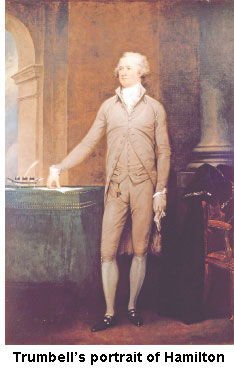LEISURE & ARTS
The Guy on the $10 Bill
Alexander Hamilton was much more.
BY JAMES TARANTO
The Wall Street Journal, Wednesday,
October 20, 2004
NEW YORK--He, more than any man, did the thinking of his time," said lawyer Ambrose Spencer (1765-1848) of his contemporary Alexander Hamilton. Today that quote appears on the wall above Hamilton's desk at the New-York Historical Society. It's part of an exhibit ("Alexander Hamilton: The Man Who Made Modern America," through Feb. 28) exploring the life and legacy of the first Treasury secretary on the bicentennial of both his death and the Historical Society's founding.
It begins with "His World," a portrait gallery featuring paintings of Hamilton and some 30 prominent figures of his day, including both allies (George Washington, John Jay) and adversaries (Thomas Jefferson, Aaron Burr). The gallery's centerpiece is a pair of busts reflecting the great ideological division of the time: between the Federalist Hamilton, who championed industry, urbanization and a strong federal government, and the Republican Jefferson, who favored an agrarian economy and states' rights.
![]()
The exhibit makes good use of multimedia. On a pair of big screens overhead plays a short film, produced by the History Channel, in which actors read contemporaneous quotes by and about Hamilton and the issues of the time. Hamilton generally gets the better of those with whom he disagreed, most strikingly in the contrast between Hamilton's belief in racial equality and Jefferson's bald racism.
The next gallery, "His Vision," is the most impressive. On one of the long walls, display cases feature artifacts from the stages of Hamilton's life: immigrant (a native of the British West Indies), soldier (a member of Gen. Washington's staff), lawmaker (the only New Yorker to sign the Constitution), economist (a founder of the Bank of New York and later President Washington's Treasury secretary), activist (including his work with the New York Manumission Society and the New York African Free School) and futurist.
 On
the opposite wall, five screens show synchronized silent films that flesh
out the idea of Hamilton as futurist, interspersing quotes from Hamilton with
contemporary scenes depicting the fruits of his ideas: the rule of law, the
free press, the economy, national defense and the city. In the middle of the
hall is a collection of original documents, including a copy of the Constitution
signed by Ben Franklin, a copy of the Federalist Papers, and various letters
and ledgers. On the wall at the end of the long hall hangs John Trumbell's
1792 painting of Hamilton.
On
the opposite wall, five screens show synchronized silent films that flesh
out the idea of Hamilton as futurist, interspersing quotes from Hamilton with
contemporary scenes depicting the fruits of his ideas: the rule of law, the
free press, the economy, national defense and the city. In the middle of the
hall is a collection of original documents, including a copy of the Constitution
signed by Ben Franklin, a copy of the Federalist Papers, and various letters
and ledgers. On the wall at the end of the long hall hangs John Trumbell's
1792 painting of Hamilton.
"His Life," the exhibit's next room, features a Hamilton timeline--nicely done but a bit spare, and thus a letdown after the far more elaborate first two halls. But Hamilton's life gets a very imaginative treatment in the exhibit's program, which is a mock issue of the New York Post--the colorful contemporary tabloid, not the gray broadsheet it was when Hamilton founded it in 1801. There's even a "Page Six" gossip column with accounts of Hamilton's complicated personal life.
![]()
One of the stories that appears there was also covered in the Nov. 24, 1801, issue of the actual New York Post: the death of Hamilton's 20-year-old son, Philip, in a duel with a political rival, George Eacker. Upon Eacker's challenge, the program recounts, Philip "went for advice to his father, who told him dueling is honorable, but killing is immoral. Therefore young Hamilton should waste his shot."
Hamilton himself would die under eerily similar circumstances less than three years later. Vice President Burr was Hamilton's bitterest foe; in the disputed presidential election of 1800, Hamilton had intervened successfully on behalf of Jefferson, whom he regarded as the lesser of evils.
In 1804, when Burr was seeking the New York governorship, a letter appeared in the Albany Register describing Hamilton's "despicable opinion" of Burr. This prompted Burr to demand a duel. Hamilton didn't want to duel, so he "tried to placate Burr with an elaborate discussion about the 'infinite shades' of meaning of the word 'despicable,'" writes historian Joanne Freedman in the New-York Journal of American History. Burr found Hamilton's attempt at nuance "evasive, manipulative, and offensive," and the two men met, with pistols--the same ones that had been used in Philip Hamilton's duel--on July 11.
Hamilton followed the same fatal advice he had given his son, deliberately missing Burr on his first shot. Burr's shot mortally wounded Hamilton. The exhibit ends with "The Duel," which features the original pistols, Hamilton and Burr's correspondence prior to the duel, Hamilton's farewell letter to his wife, and Kim Crowley's life-size bronze statues of the men, commissioned especially for the exhibit, which depict them as they were the moment before they fired--10 paces apart, with Hamilton's gun pointed slightly off target.
Hamilton was only 47 when he died, and most Americans know him today only as the guy on the $10 bill. Visitors to the New-York Historical Society will come away with a newfound appreciation for the many contributions he made to America in his short life.
Next article: Now Tell Me Who Won (11/3/04)
Previous article: Gloom Is Not a Plan (9/30/04)